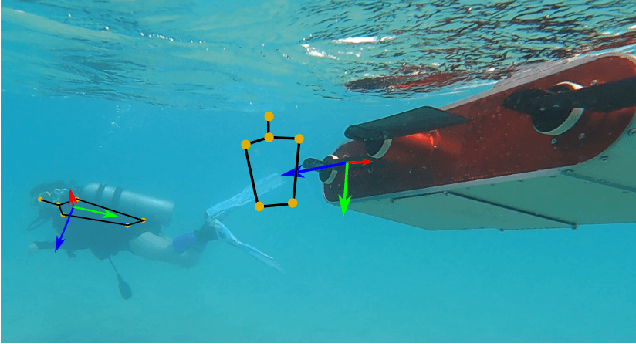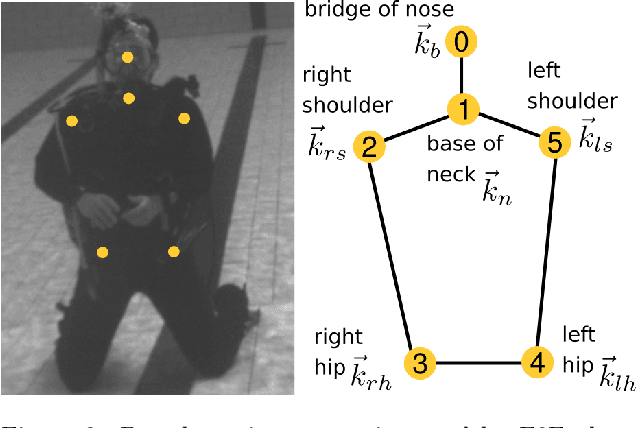Demetrious T. Kutzke
Autonomous robotic re-alignment for face-to-face underwater human-robot interaction
Jan 09, 2024



Abstract:The use of autonomous underwater vehicles (AUVs) to accomplish traditionally challenging and dangerous tasks has proliferated thanks to advances in sensing, navigation, manipulation, and on-board computing technologies. Utilizing AUVs in underwater human-robot interaction (UHRI) has witnessed comparatively smaller levels of growth due to limitations in bi-directional communication and significant technical hurdles to bridge the gap between analogies with terrestrial interaction strategies and those that are possible in the underwater domain. A necessary component to support UHRI is establishing a system for safe robotic-diver approach to establish face-to-face communication that considers non-standard human body pose. In this work, we introduce a stereo vision system for enhancing UHRI that utilizes three-dimensional reconstruction from stereo image pairs and machine learning for localizing human joint estimates. We then establish a convention for a coordinate system that encodes the direction the human is facing with respect to the camera coordinate frame. This allows automatic setpoint computation that preserves human body scale and can be used as input to an image-based visual servo control scheme. We show that our setpoint computations tend to agree both quantitatively and qualitatively with experimental setpoint baselines. The methodology introduced shows promise for enhancing UHRI by improving robotic perception of human orientation underwater.
Design and Development of a Remotely-enabled Modular Release Mechanism for Autonomous Underwater Vehicles
Jan 08, 2024Abstract:We introduce a launch device, called the remotely-enabled modular release mechanism, to augment rapid testing and prototyping of cooperative autonomy maritime applications by facilitating autonomous deployment of an autonomous underwater vehicle (AUV) from an autonomous surface vessel (ASV). While we focus our development on a specific application of deploying an AUV from a catamaran style ASV, the release mechanism can be adapted to different deployable objects and towing vehicles, such as buoys and sensors for oceanographic surveys or mono-hull ASVs. In this paper we explore a number of hardware and software design considerations to facilitate ease of integration with existing maritime autonomy systems. We expound on bench tests and in-water tests used to explore the utility of the release system and diagnose system issues. Additionally, we make a first-principles argument, based on a hydrodynamics physics model, for assured deployment that is virtually independent of sea state, making the release system a suitable alternative for different maritime applications in varying environmental conditions.
Robotic Detection and Estimation of Single Scuba Diver Respiration Rate from Underwater Video
Nov 24, 2023Abstract:Human respiration rate (HRR) is an important physiological metric for diagnosing a variety of health conditions from stress levels to heart conditions. Estimation of HRR is well-studied in controlled terrestrial environments, yet robotic estimation of HRR as an indicator of diver stress in underwater for underwater human robot interaction (UHRI) scenarios is to our knowledge unexplored. We introduce a novel system for robotic estimation of HRR from underwater visual data by utilizing bubbles from exhalation cycles in scuba diving to time respiration rate. We introduce a fuzzy labeling system that utilizes audio information to label a diverse dataset of diver breathing data on which we compare four different methods for characterizing the presence of bubbles in images. Ultimately we show that our method is effective at estimating HRR by comparing the respiration rate output with human analysts.
 Add to Chrome
Add to Chrome Add to Firefox
Add to Firefox Add to Edge
Add to Edge